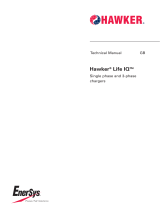
The discharge may also be measured by means of an
Ah counting device with an accuracy of ± 1% of the
expected current range.
Figure 3
3.3 Recharge in Controlled PSoC Operation
There are several methods that can be utilised to control
the recharge time:
1. Current absorption rate: The recharge can be stopped
when the current being absorbed by the battery falls
below 0.075C10 A, or after the calculated recharge time
is achieved, whichever occurs first.
The recharge time during the PSoC cycling maybe
calculated based on the Ah removed and charge
current:
Recharge time (hours) = 2* ((0.8 x discharged Ah) /
current limit).
2. Ah counting: A controlled recharge can be achieved
by Ah counting using a device with an accuracy
of ± 1% of the expected current range. However,
inaccuracies associated with equipment calibration
and/ or controller algorithm accuracy can lead to drift
in determining the true SoC, meaning that, after a
periodic equalisation charge, a recalibration of the
SoC is required. Where Ah counting is used to control
PSoC, a recharge of 100% to 101% of the discharged
Ah should be returned between discharge micro
cycles.
3.4 Full Recharge & Equalisation
It is critical to ensure that the battery is periodically
returned to a full state of charge to maintain the battery
state of health.
Full charge and equalisation should be applied periodically,
equivalent to either 4x energy throughput relative to
nominal capacity or if on-load voltage falls to 1.96Vpc,
whichever occurs first.
Once full state of charge is achieved, equalisation should
be applied for 4 hours using 2.40Vpc at 20°C. Full state of
charge is determined when the current absorbed by the
battery is stable over a period of 1 hour.
Temperature compensation to the charge voltage should
be applied as detailed in section 2.5.
3.5 Data Recording
It is recommended that as a minimum, the following
information be recorded by means of regular data
logging. The user must make this available to EnerSys® in
order to validate any warranty claim.
1) Records of the commissioning charge.
2) The number of cycles performed and the depth of
discharge of each cycle.
3) The duration of each discharge and charge cycle, and
the Ah in and out (Wh in and out).
4) Full details of the recharge voltage/current profile for
the last 50 cycles.
5) A full history of the ambient and battery surface
temperatures, recorded at regular intervals throughout
battery operation and life.
6) The time and date of each “event” (an “event” is
defined as the start/stop of the battery discharge, the
start/stop of the battery recharge, the start stop of any
generator input power or other input power source, etc.).
4. Disposal
SuperSafe® SBS XC+ products are recyclable. End of life
batteries must be packaged and transported according to
prevailing transportation rules and regulations. End of life
batteries must be disposed of in compliance with local
and national laws by a licensed battery recycler.
Warning
In hybrid applications it is important that the maximum
temperature of the battery in operation does not exceed +50°C.
Continuous charge at 2.40Vpc will significantly reduce the
battery life.
EnerSys World Headquarters
2366 Bernville Road, Reading,
PA 19605, USA
Tel: +1-610-208-1991 /
+1-800-538-3627
EnerSys EMEA
EH Europe GmbH
Baarerstrasse 18
6300 Zug
Switzerland
EnerSys Asia
152 Beach Road,
Gateway East Building #11-08,
Singapore 189721
Tel: +65 6416 4800
©2021 EnerSys. All rights reserved. Trademarks and logos are the property of EnerSys and its affiliates unless otherwise noted. Subject to revisions without prior notice. E.&O.E.
Publication No.: APAC-OGH-EN-SS-SBS-XC+-002 - 0719
Contact:
On-load Voltage as a Function of Rate and Depth of Discharge
% Depth of discharge
10 100
2.15
2.1
2.05
2
1.95
1.9
1.85
1.8






